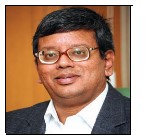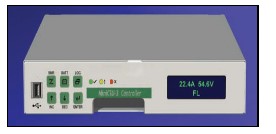 — B. Venkataramana,
Executive Director, VMC Systems Ltd
— B. Venkataramana,
Executive Director, VMC Systems Ltd
Hyderabad-based
VMC Systems Ltd is India's largest telecom and
power-conversion equipment manufacturer. Under an agreement
with Australia-based Rectifier Technologies Pacific Pty Ltd, VMC
plans to introduce in India high-wattage DC Power Systems built
with SMPS technology.
B. Venkataramana expounds on this
technology and explains the significant efficiency of these systems
vis-à-vis the conventional thyristor-based technology. Venkatarama
is confident that this new breed of smart and scalable DCPS, will
find increasing demand from the next-generation requirements of
utilities. An interview by
Venugopal Pillai.
To begin with, please tell us in simple terms what power
conversion (AC to DC and vice versa) means and what role this
plays in the supply and consumption of electric power.
All electronics and electrical devices need electricity to
function, whether it is to power a simple mobile handset, to a
cellular base-station, or even a high data
centre. However, for each of these
equipments, the operating voltages are
different; typically in industrial and
commercial applications, you will see
operating voltages starting ranging from
24VDC to 220VDC.
However, since the most commonly
available power source, is the "socket on the
wall 230V AC, to use this power source for
industrial and commercial applications, one
needs to first "convert" the power from AC to
DC, and then "condition" the voltage to the
voltage requirement of a particular device
[i.e. step down from 220V AC to 24V, 48V,
etc, in the DC range]. For areas where there is no availability of
AC power [or when AC power temporarily goes down], one
needs to provide power-supply from battery. The need for these
two applications saw the development of rectifiers and
inverters.
A rectifier is a device that converts from AC to DC, and an
inverter is one that does the reverse, which means it converts
DC power to AC.
Can you illustrate with an example?
From a commercial applications perspective, let us use the
example of the power requirements in a cellular base-station.
Under normal conditions, the primary power source is AC, and it
can come from either the power utility ["socket on the wall" 230V
AC, or from an AC generator. But since BTS
(base transceiver station) is based on DC
power, the AC first needs to be converted to
DC; which is done by feeding the AC input into
a Rectifier; the output of the rectifier then
becomes the primary source of power for all
of the equipment within the BTS cellular
station. A secondary output from the
rectifier charges a bank of batteries that
kick-in, when there is a power failure.
In some cases there may be legacy
systems [which require 230VAC only], but if
there is no 220VAC available except for a
bank of batteries, then one would need an
Inverter, which takes the DC power coming
from this battery bank as input, and converts into 230VAC on the
output side, and feeds that legacy system.
 What is the size of the Indian power conversion market and
what is likely to be the growth rate in the medium term? What
will be the major business drivers?
What is the size of the Indian power conversion market and
what is likely to be the growth rate in the medium term? What
will be the major business drivers?
Our conservative estimates for the industrial/commercial
segments work out to be in excess of Rs.1,000 crore per year at a CAGR of at least 20 per cent. Primary growth drivers would be
telecommunications (both the 3G roll-out as well as broadband
expansions), as well as the focus from government from an
infrastructure development perspective in the upcoming XII
Plan period.
Please tell us about the SMPS-based high-wattage DC Power
Systems that VMC plans to manufacture in India in collaboration
with Australia-based Rectifier Technologies Pacific.
These DCPS are based on SMPS technology, which are lighter,
smaller, and modular in nature compared to traditional DC
Power Systems [which are thyristor-based]. In addition to the
small foot print and ease of install; other key USPs includes
features such as remote management and programmability of
these systems without the need to add additional components
into the systems. These features bring in aspects of
intelligence, "smartness", and future-proofing into such
systems - allowing us to bring India's power management
capabilities in a variety of applications like power distribution
utilities [SCADA] and telecommunications power manageability,
on par with rest of the world.
What was the rationale behind selecting RTP as your
technology partner?
RTP is a very focused company that specializes in the design
of DC power systems for a variety of commercial and
industrial applications. They have built a reputation over the
years in this industry for innovation and reliability of their
SMPS based technology, and has a large installed base
worldwide. It was these factors that made them a natural
choice for us for this collaboration.
How does the SMPS-based technology for DC power systems
differ from the extant thyristor-based technology?
In addition to the technical advantages that I spoke of earlier,
SMPS-based DC power systems are much higher-efficiency
systems than traditional thyristor-based systems with much almost
unity power factor. From a commercial perspective also, SMPSbased
DCPS are much more friendly CapEx perspective, being
economical over the latter by 20-40 per cent. Further, because of
their modularity, they can be quickly replaced through a simple plugin
thereby reducing downtime, from around 8 hours to less than 10
minutes! Bottom-line, either from an ROI or a TCO perspective,
SMPS-based DCPS are way ahead of their Thyristor counterparts.
Given that this technology is unprecedented, what challenges
do you foresee in its acceptance in India?
Thyristor-based systems were introduced in the early 1970s,
and their advent in India was in the mid-1980s. As is the case
with any legacy system, inertia and hesitancy to move from the
"tried and tested" will be the primary challenge. However, with
rapid growth in infrastructure and pressures from both cost as
well as features standpoint, we believe the case is clear for such
next generation technology.
 Tell us about the principal demand drivers of DC
power systems?
Tell us about the principal demand drivers of DC
power systems?
There are a variety of applications such as SCADA (Supervisory
Control and Data Acquisition) for utilities [including power, oil &
gas, etc]; telecommunication and data centres; railways; metro
rail applications, etc.
Given that various state governments are implementing ITbased
initiatives under RAPDRP-Part A, tell us in particular
about the demand from electricity distribution utilities.
Part-A is limited to data-centres. It is in Part-B where there is
requirement for DCPS type of systems. The role for DCPS in RAPDRP
would be to power RTUs, and help in the connectivity
and remote manageability of these various substation systems
with a central monitoring system in the state headquartered
control room.
Do DC power systems have a role to play in HVDC power
transmission infrastructure?
Absolutely!
Tell us about the new manufacturing facility in terms of location,
investment, current status and expected commissioning date.
VMC has a state-of-the-art facility in Hyderabad which has
around 75,000 sqft manufacturing floor space. It is currently
operational, with world-class manufacturing equipment. It is
located in Hyderabad, Andhra Pradesh, only 10 minutes from
the international airport.